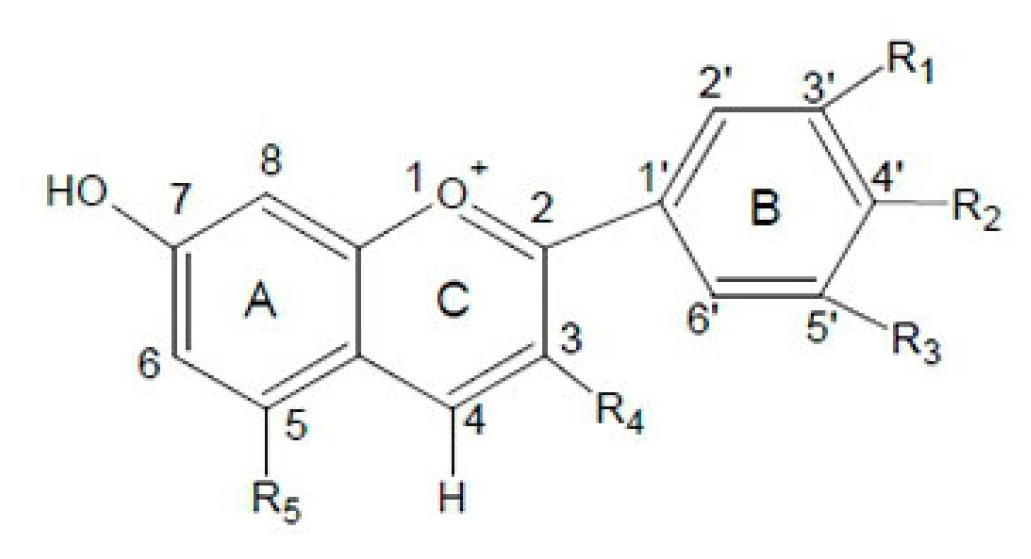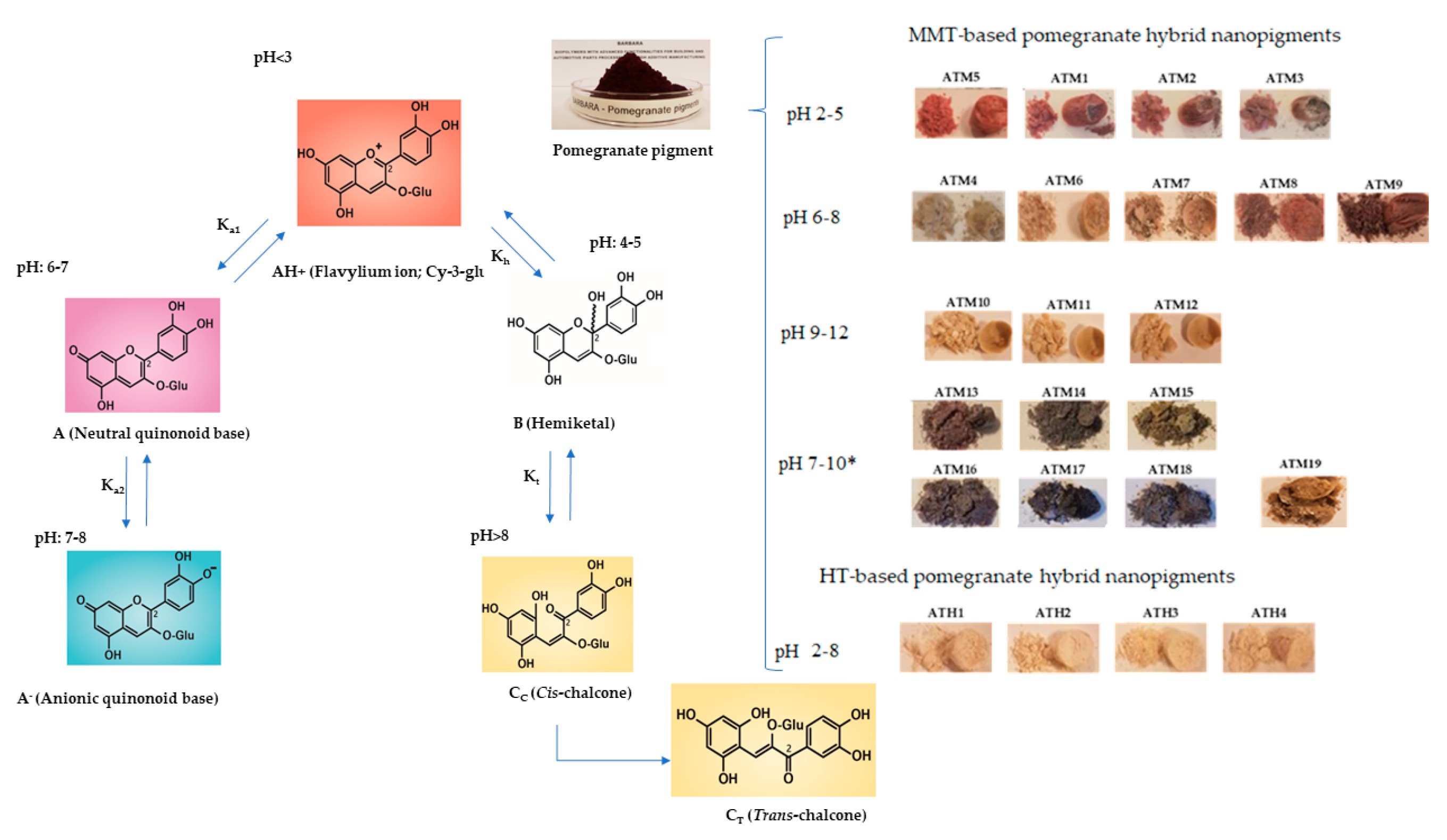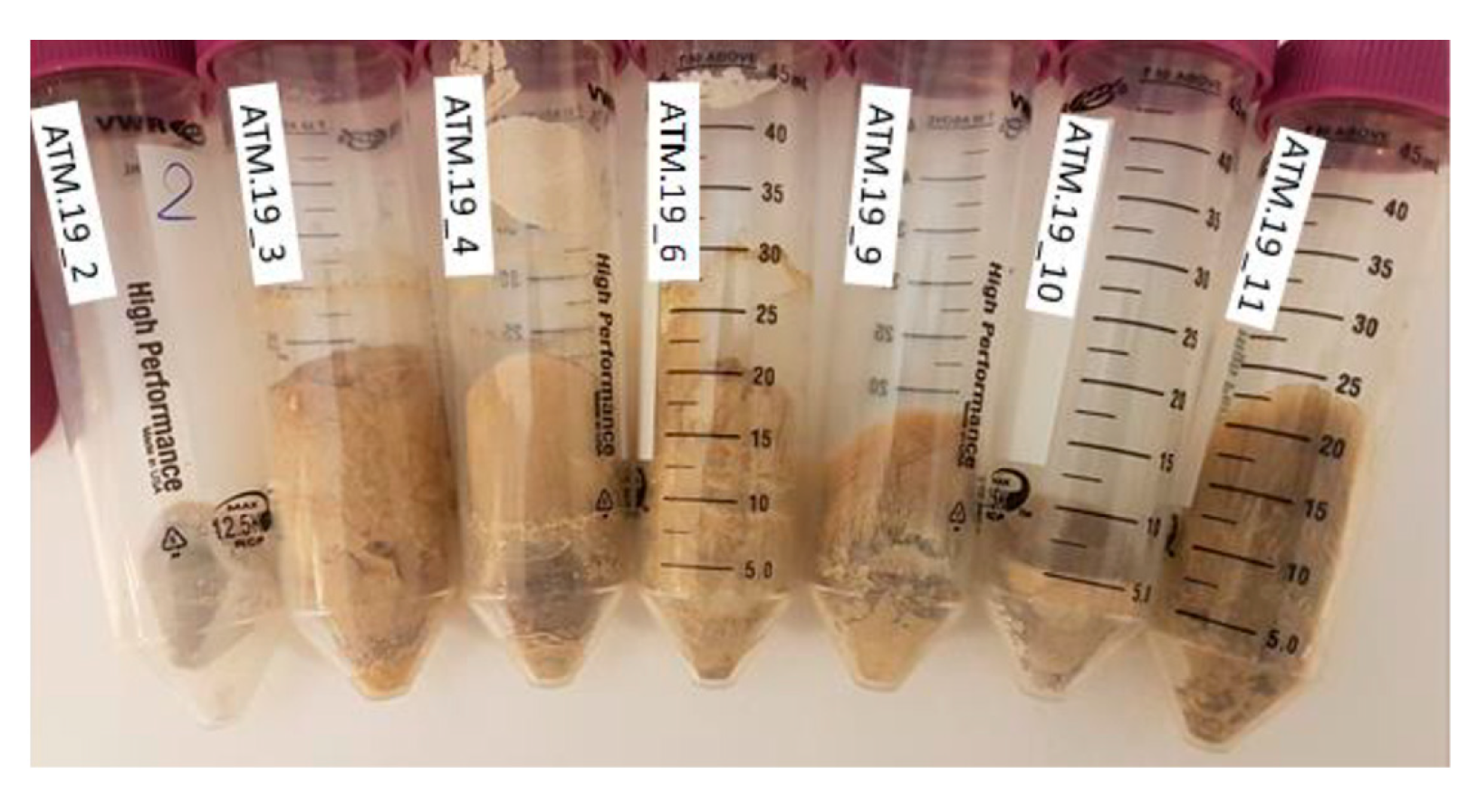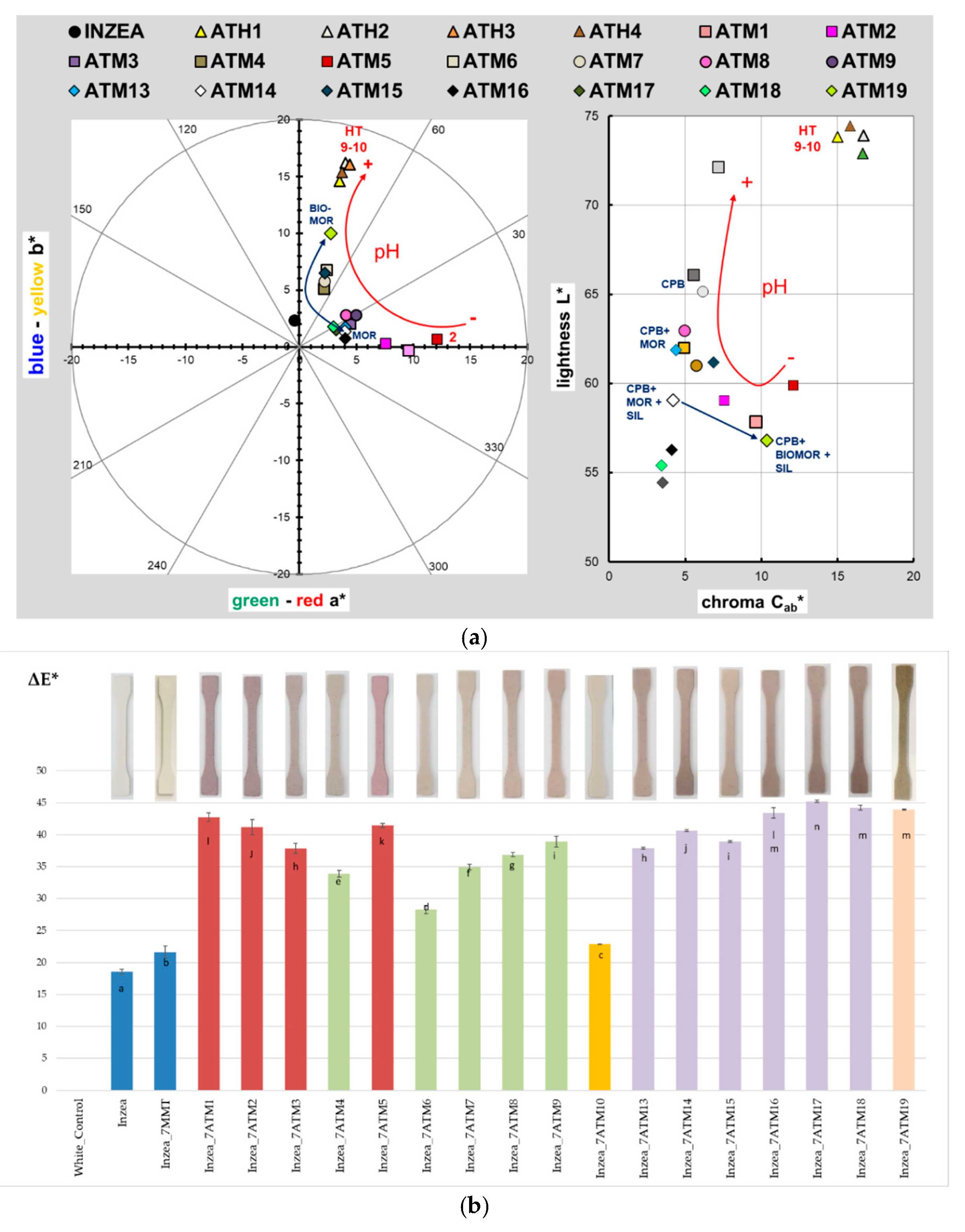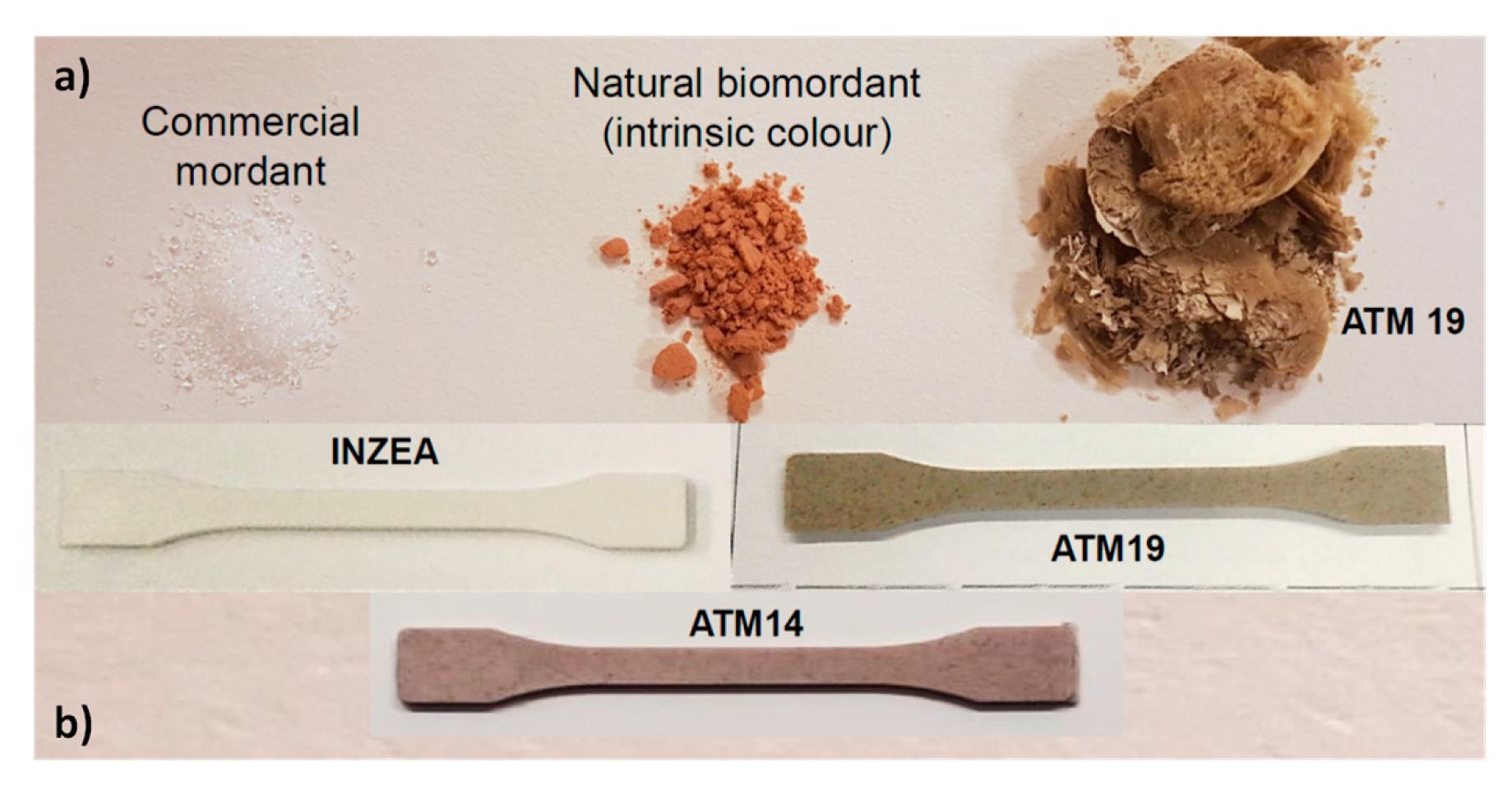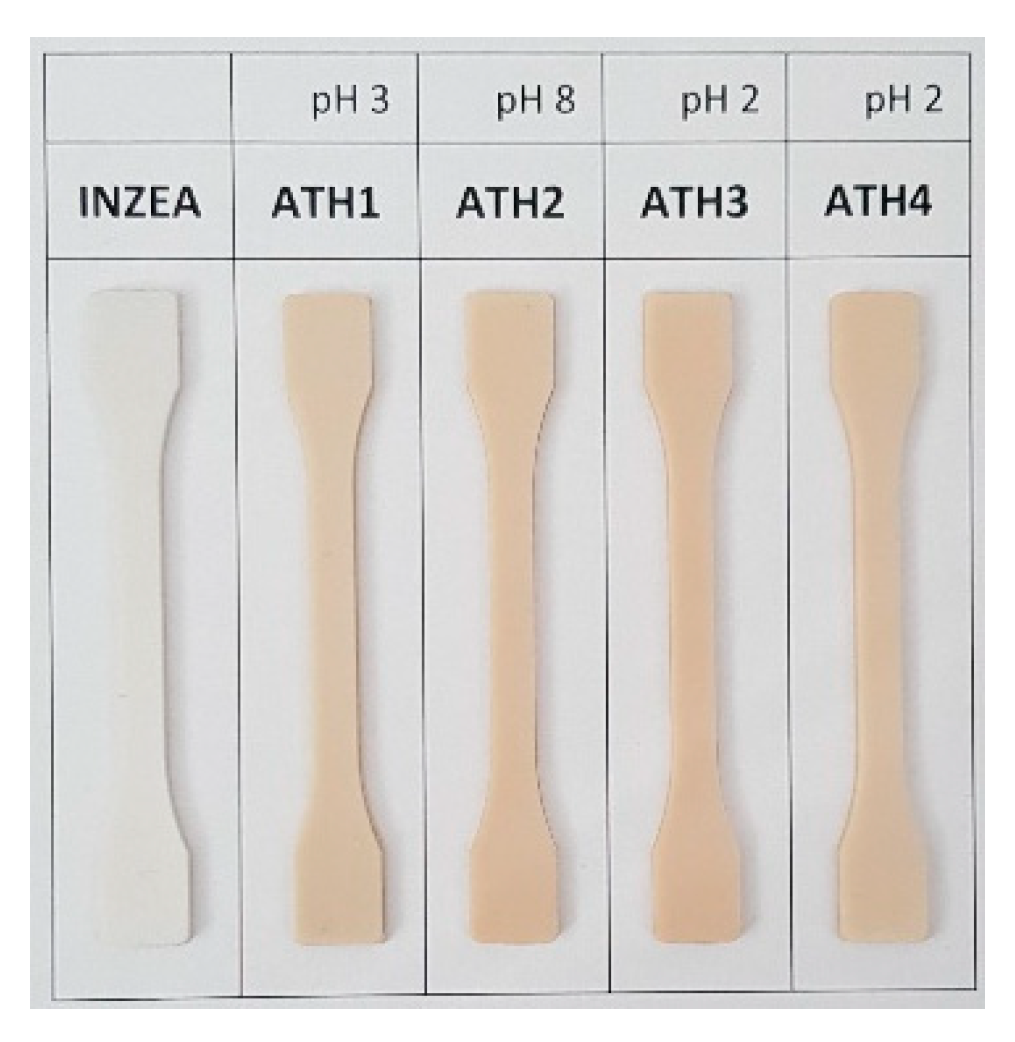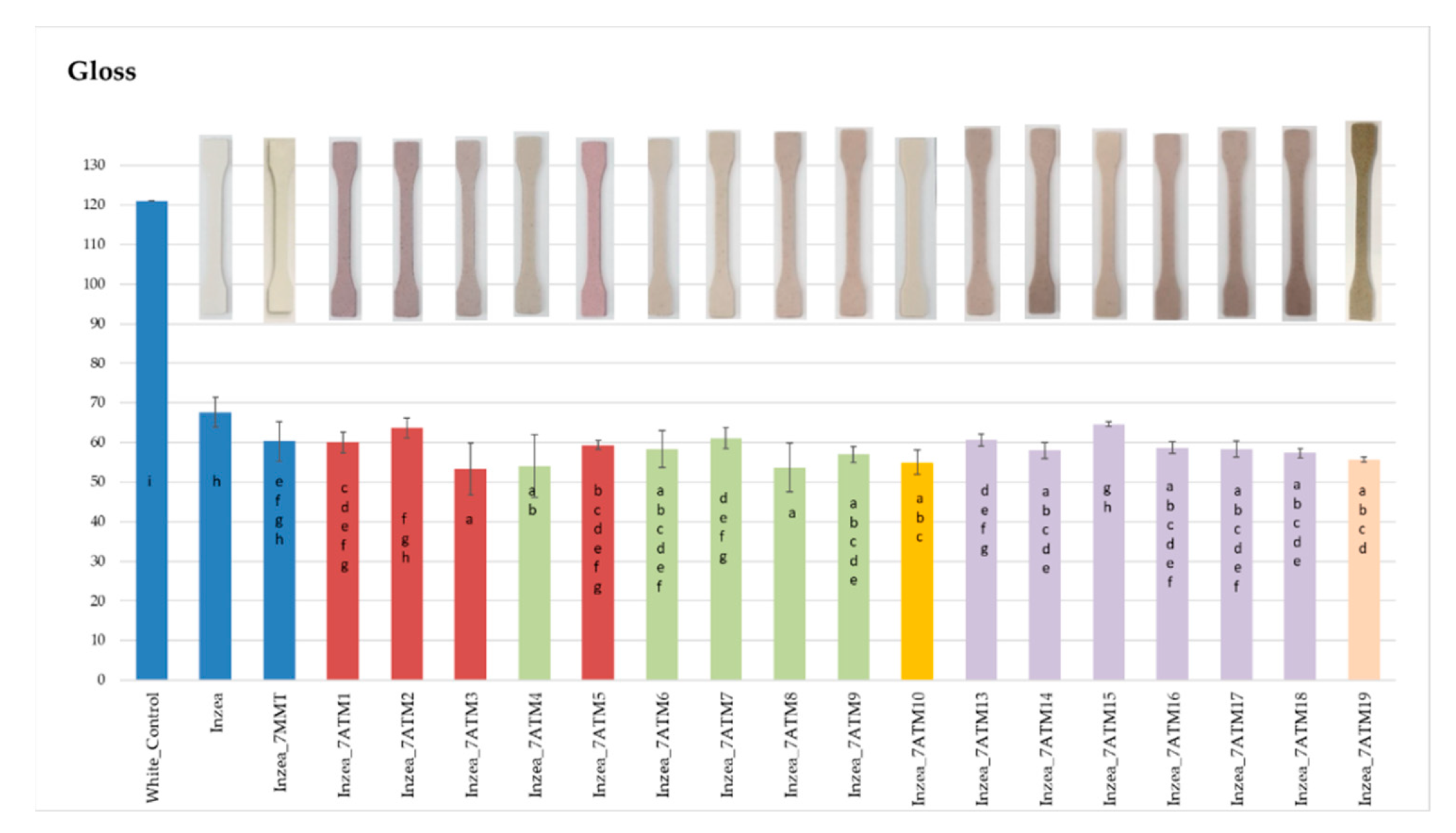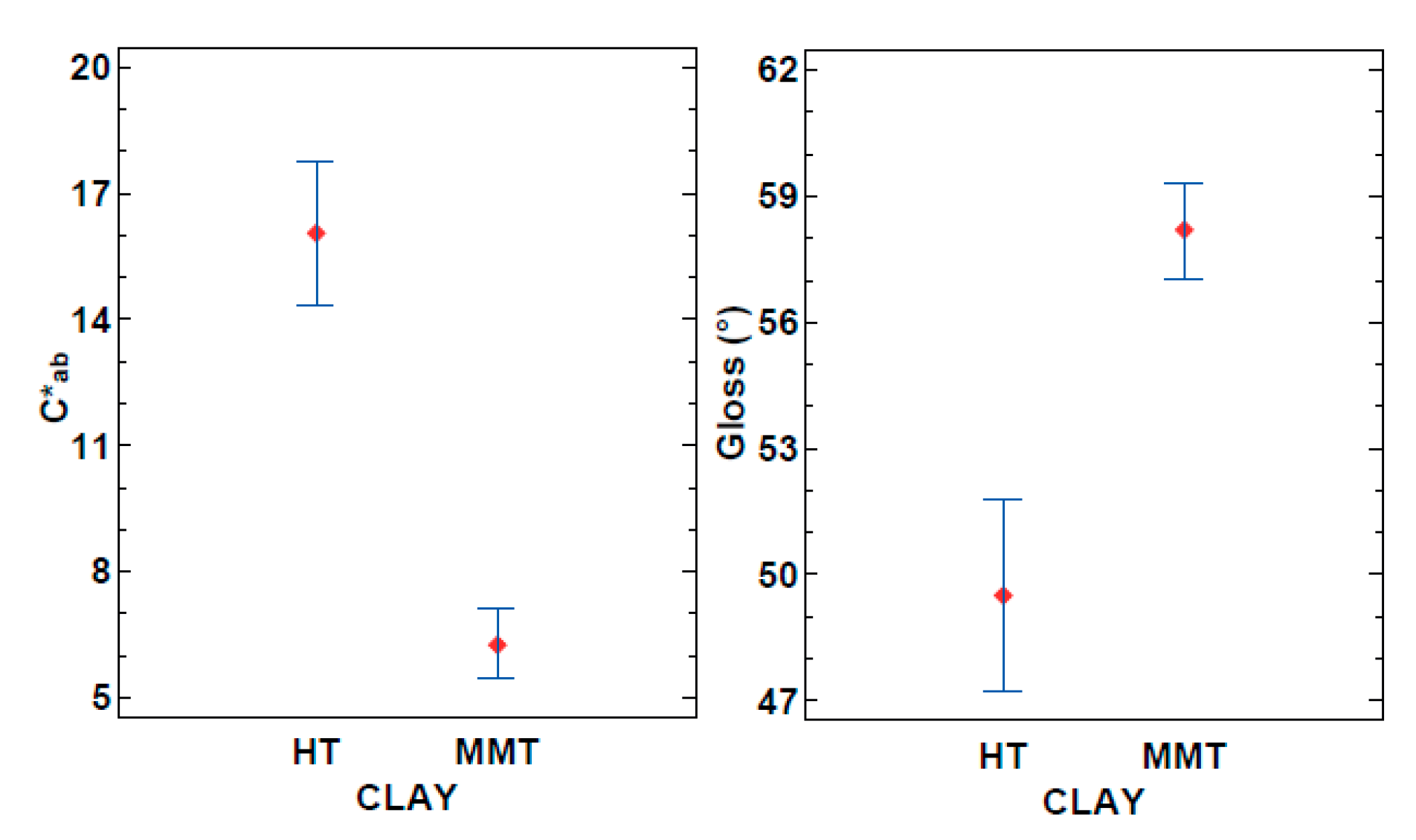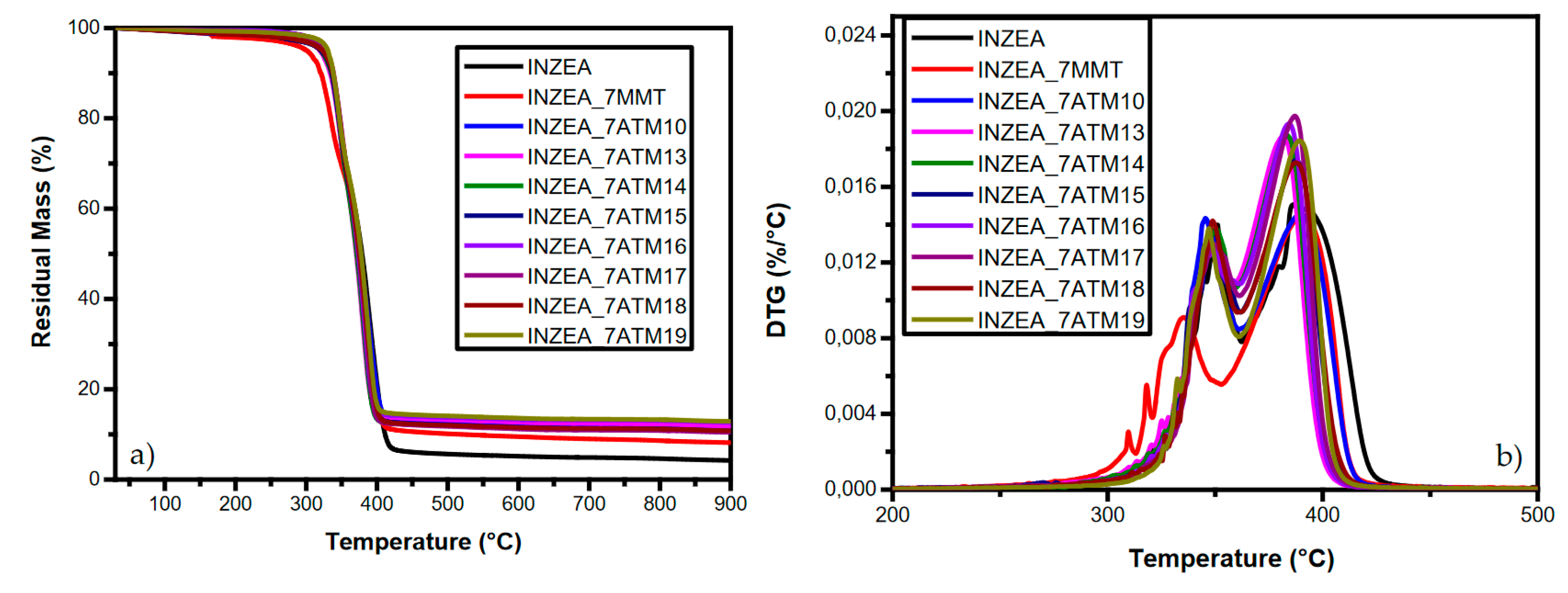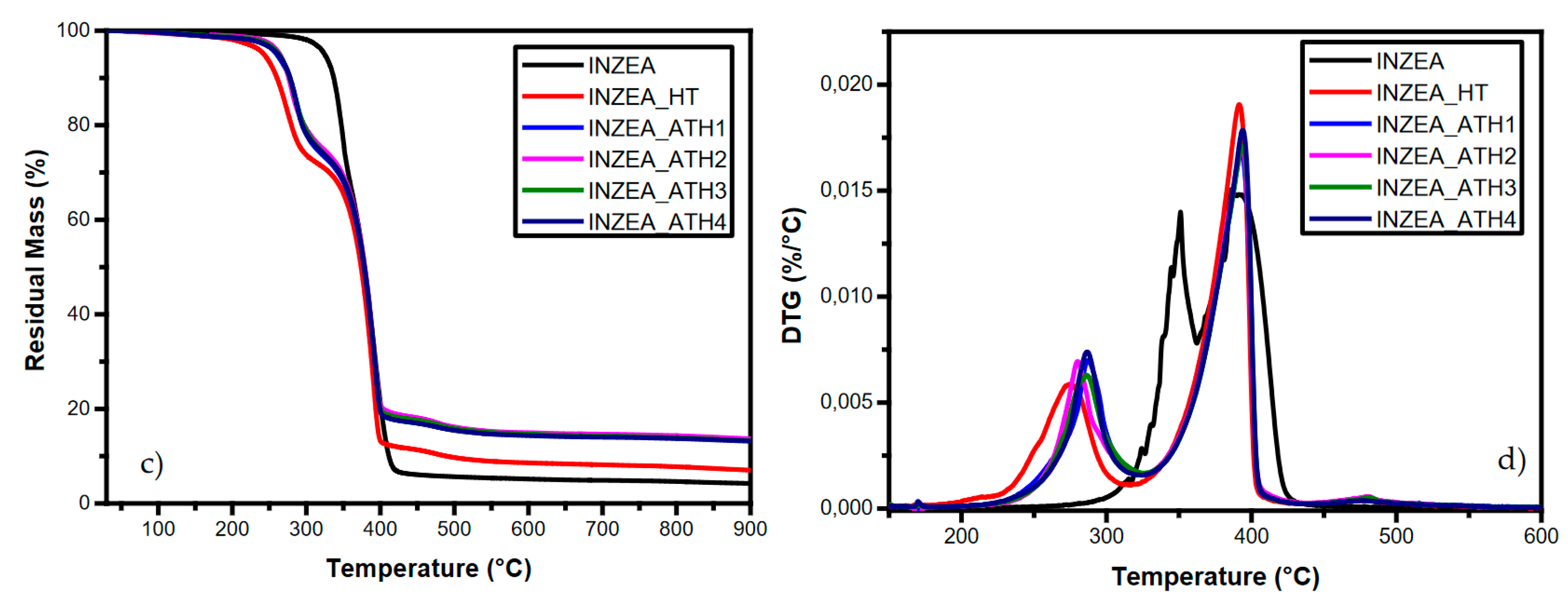1. Introduction
In the last decades, dyes/pigments and clays were largely used and applied to create coloured design materials. The prospective and application of natural dyes and pigments extracted from natural sources (fruits, vegetables and in general from natural wastes) [
1,
2] represent an eco-friendly and non-toxic strategy to limit the use of chemical-based products. The environmental problems related to chemical pollution have encouraged the replacement of synthetic dyes by natural extracts, which exhibit better biodegradability and are able to minimize the health hazardous problems and negative aspects related to genotoxicity, cytotoxicity and carcinogenicity of synthetic dyes [
3,
4,
5]. Polyphenolic dyes extracted from plant leaves and pomegranate rind were used as an alternative eco-friendly approach for nylon dyeing [
6]. Natural pigments were also added to polymer matrices not only for colouring purposes, but even for their deodorant, antioxidant and antimicrobial properties [
7]. Mitrae et al. proposed the use of tomato-based pigments as colouring agents in poly(vinyl alcohol)-based films [
1]. Other studies also focused on the dyeing properties of polypropylene and polyamide-based systems prepared by melt compounding the polymer with six-layered clays. Razafimahefa et al. found that the introduction of nanoclays improved the dyeing ability of nylon added with dispersed dyes [
8,
9] and they proposed the production of dyeable polypropylene fibres added with nanoclay particles in the polymer matrix.
The dyes responsible for different colours such as blues, reds and purples in many flowers, fruits and vegetables are members of a subclass of flavonoid colorants known as anthocyanins (ACNs). ACNs present great antioxidant activity against many chronic diseases and numerous studies reporting their nutritional, medicinal and therapeutic value can be found [
10,
11,
12]. These compounds can be used as natural food colorants and pH indicators in aqueous solutions due to some modifications in their structure, undergoing a variety of molecular rearrangements with changes in pH, resulting in colour changes from blue to red [
13,
14]. This behaviour is mainly attributed to the number of hydroxyl and methyl groups present in the ACN molecular structure and these colour changes are the result of the rearrangement of one compound, unlike universal indicators, which use several different compounds to get the same effect [
15]. Intelligent pH indicative polymer films containing ACNs extracted from different wastes, such as red cabbage [
16] and rose [
17] were produced. However, the colour and stability of ACNs are mainly influenced by pH, co-pigmentation and solvent effects, temperature, oxygen, light and structure [
18]. Therefore, ACNs are unstable, and they can suffer chemical transformations depending on the medium conditions which could limit their wide applications. The development of stabilization strategies to improve the colour stability of ACNs such as the addition of co-pigments, formation of supramolecular complexes and encapsulation systems, and protection with natural clay minerals were proposed by Li et al. [
19]. In this sense, it has been proved that colour stabilization can be achieved by using hybridization of clay nanostructures [
20,
21,
22]. A number of recent studies have focused on the adsorption of ACNs to obtain dye/clay hybrid pigments with improved colour fastness and stability which include reports of stable hybrid pigments prepared from ACNs and several clay minerals that undergo reversible pH-dependent colour changes [
23,
24,
25]. Li et al. [
21] incorporated ACNs extracted from fresh blue berry fruits into different clay minerals including tubular halloysite, fibrous sepiolite, lamellar kaolinite and montmorillonite to obtain reversible allochronic hybrid pigments. Lima et al. [
26] developed hybrid pigments based on organo-saponite (cetyltrimethylammonium bromide) and ACNs from red grape. They observed a stabilization of the different chemical structures of ACNs (blue quinoidal base form and red flavylium cation), exhibiting the resulting hybrid reversible acid/base chromism from blue to red and vice versa. In addition, saponite showed a cation exchange mechanism that led to the intercalation of the flavylium cation of the natural dye as well as intermolecular interactions in the stabilization of the quinoidal base form.
Pomegranate (
Punica granatum L.) is a well-known edible fruit widely consumed as fresh fruit and juice and it is considered a ‘super fruit’ since it is rich in antioxidant phytochemicals, being recognized for a myriad of health benefits [
27,
28,
29]. Moreover, the juice is gaining popularity worldwide for its uniqueness, exclusive colour, taste and high content in phytochemicals, mainly polyphenols. Most studies on pomegranate have focused on polyphenols, flavonoids, hydrolysable tannins (ellagitannins), anthocyanins, anthocyanin−flavanol and flavanol−anthocyanin adducts, and proanthocyanidins. Among the ACNs pigments, cyanidin-3-glucoside is the major anthocyanin found in most of the plants, particularly in pomegranate juice [
14].
Surfactants, mordant salts and silane agents (as well as the combination of these components) have been used in nanoclay structures to obtain high-performing hybrid nanopigments. These modifiers can open the laminar nanoclay structures and improve their exchange and adsorption dye (dyeability) capacities. The use of design of experiments (DoE) has been also considered to find the best combination of modifiers in nanopigments synthesis to maximize the adsorption dye capacity and the thermal stability of the natural dyes, in view of their application as polymer additives in biopolyester-based formulations, obtaining acceptable thermal, mechanical and colour stability performance [
30]. Regarding mordant salts, new plant species have been proposed as a source of sustainable metal salt-free biomordants to replace metallic and toxic mordants. Rather et al. [
31] and Ul-Islam et al. [
32] reported an improvement in wool dyeing when using natural tannin mordants extracted from pomegranate peel, babool bark, catechu and gallnut resulting in a broad colour spectrum an acceptable colour strength and fastness properties. In our work, tannins extracted from pomegranate peels were used in order to test the effectiveness of this biomordant obtained from the same waste.
The research in hybrid materials based on the use of clay minerals and natural pigments has continuously increased during the last decades [
33,
34,
35]. ACNs were used in food packaging applications for the development of intelligent films with reversible acid/base allochronic behaviour [
23], new colorimetric films based on pH using mulberry ACNs, ethylene-vinyl alcohol copolymer and montmorillonite [
33]; intelligent nanocomposite films based on chitosan and poly-vinyl alcohol with ACNs from black carrot [
36] or active intelligent nanocomposite films based on ethylene vinyl acetate containing ACNs from rosemary extract and ZnO/Fe-MMT nanoparticles [
37]. Therefore, the wide palette of ACNs colours combined with the stability offered by clay minerals have improved the applicability of the obtained hybrid pigments in sectors such as food packaging and textile fabrics [
38]. Despite the wide use of modified clays to enhance the stability of organic dyes, a minimal number of works have studied the synthesis of hybrid nanopigments by using design of experiments. In addition, to the best of our knowledge, the stability enhancement of natural pomegranate waste pigments at different pH values on modified clays and the further incorporation of the synthetized hybrid pigments in polymer materials have not been explored yet.
The aim of this work was the incorporation of a pomegranate dye, rich in ACNs and extracted from agricultural fruit wastes, into different nanoclay structures (MMT, HT) to obtain anthocyanin hybrid nanopigments to be used as biopolymer colouring and reinforcing additives. The interactions between ACNs and nanoclays were also investigated in terms of colour behaviour with pH. The possibility of replacing a traditional commercial mordant salt by a biomordant obtained from pomegranate peels was also studied. Novel polyester-based bionanocomposites containing 7 wt% of the hybrid nanofillers were developed and characterized in terms of thermal, mechanical and colour properties. Life cycle analysis (LCA) was considered to verify the environmental impact of the selected procedures for clay functionalization as a function of clay typology. Differences in environmental profiles were also evaluated for polymer materials obtained by using the commercial polyester matrix and for the different developed nanopigments.
2. Materials and Methods
2.1. Materials and Reagents
Pomegranate waste was obtained from discarded whole fruits from FECOAM (Murcia, Spain). Pomegranate fruits were cleaned, and the husk was then removed manually in order to obtain pomegranate peels. A pomegranate natural pigment rich in ACNs was obtained from pomegranate juice and supplied by Celabor scrl (Herve, Belgium).
Two laminar nanoclays with different ion exchange properties, anionic hydrotalcite (HT) and cationic montmorillonite (MMT), were selected in this work based on previous research with laminar nanoclays and the enhanced properties found in different polymer matrices by achieving laminar nanoclay exfoliation [
39]. Hydrotalcite (HT, BioUltra, ≥99.0%) and montmorillonite (MMT, Gel White) were supplied by Sigma-Aldrich (St. Louis, MO, USA) and Southern Clay Products (Gonzales, TX, USA), respectively. HT was calcined at 600 °C for 3 h before use. Sodium dodecyl sulphate (SDS) and cetylpyridinium bromide (CPB) were used as surfactants for HT and MMT, respectively. Aluminium potassium sulphate dodecahydrate and (3-Aminopropyl) triethoxysilane were also used as mordant salt and coupling agent modifiers, respectively. All reagents and chemicals were of analytical grade, and they were purchased from Sigma-Aldrich (St. Louis, MO, USA).
For bionanocomposites preparation, INZEAF2 biopolyester commercial grade (moisture content <0.5%, density of 1.23 g cm−3 measured at 23 °C, melt flow rate of 19 g/10 min (2.16 kg, 190 °C)) was kindly supplied by Nurel (Zaragoza, Spain).
2.2. UPLC-DAD-MS Analysis of Pomegranate Natural Pigment
The identification and quantification of the major ACNs present in the pomegranate natural pigment was performed, in triplicate, by UPLC-DAD-MS. A Waters UPLC system coupled to a Xevo TQ-S detector (Waters Corporation, Milford, MA, USA) was used. Chromatographic separation of ACNs was performed with an ACQUITY UPLC Shield RP18 column (100 mm × 2.1 mm I.D. × 1.7 µm) (Waters Corporation, Milford, MA, USA) at 40 °C and a flow rate of 0.5 mL min−1. Then, 20 mg of pigment were dissolved in 5 mL of MeOH:formic acid 0.1% (v/v) in an ultrasonic bath for 15 min and passed through a 0.22 µm poly(tetrafluoroethylene) (PTFE) filter. The mobile phase was composed of ultrapure water containing 0.6 wt% formic acid and 126 mg ammonium formate (A) and acetonitrile (B). The linear gradient used was: 1% B to 21% B (5 min) to 100% B (4 min), 100% B (2 min), 100% B to 1% B (1.5 min) and 1% B (3.5 min). A total of 2 μL of sample was injected and UV–Vis chromatograms were recorded at 280 nm. Spectra were acquired in the negative ionization mode. Desolvation was carried out with a N2 gas flow of 800 L h−1 and 550 °C. Cone voltage was set at 2 kV. Specific multiple reaction monitoring (MRMs), cone and collision voltages were used for each compound, as detailed in Table 2. Quantification of major ACNs was performed based on integrated peak areas of samples and standards diluted in MeOH:formic acid 0.1% (v/v) using external calibration (1–10 mg kg−1).
2.3. Pomegranate Biomordant Extraction
The biomordant used in this work was obtained by microwave-assisted extraction (MAE) using a FLEXIWAVE™ microwave oven (Milestone srl, Bergamo, Italy) [
40]. Pomegranate peels were dried at 40 °C for 24 h in a climatic chamber (Dycometal, Barcelona, Spain) at 25% of relative humidity (RH). Dried peels were ground with a high-speed rotor mill at 12,000 rpm (Ultra Centrifugal Mill ZM 200, RETSCH, Haan, Germany) to obtain a powder of 0.5 mm of particle size. Then, MAE was carried out with 6 g of sample mixed with 60 mL of 40% (
v/
v) ethanol for 10 min at 65 °C. The obtained biomordant extract was filtered and purified by adding 96% (
v/
v) ethanol at −20 °C overnight to precipitate polysaccharide compounds. After that, the sample was vacuum-filtered and the solvent was removed by using a rotary evaporator (R-300, Büchi Labortechnik AG, Switzerland). The final aqueous solution was freeze-dried (LyoQuest Plus, Telstar, Terrassa, Spain) and the purified biomordant was stored in the darkness at room temperature until further use.
2.4. Synthesis of Pomegranate Hybrid Nanopigments (PDNPs)
The synthesis of pomegranate hybrid nanopigments (PDNPs) was performed by using the water/organic solvent dispersion method, based on previous works [
7]. For the synthesis of MMT-based PDNPs, mechanical stirring at 1800 rpm for 24 h in distilled water was performed to ensure the maximum nanoclay (25 g L
−1) swelling. The different pH values were reached by using an aqueous HCl solution (2 mL L
−1). The pomegranate dye (PD) was added after the preparation of a high dye concentration solution in distilled water. The PD dispersion was carried out at 1800 rpm for 20 h after the dye solution addition. After that, the dispersion speed was reduced to 600 rpm for 4 h as an aging step. The addition of surfactant and/or mordant additives was performed before the dye addition, while silane was added after the dye exchange. The whole process was carried out at room temperature. Solvent separation was performed by centrifugation obtaining a paste-like nanopigment which was finally freeze-dried for 24 h. A similar procedure was used for HT-based PDNPs but using 50% (
v/
v) ethanol as solvent for nanoclay dispersion.
For MMT-based PDNPs, a first set of experiments was designed to combine MMT nanoclay with pH changes and the presence of different modifiers (commercial mordant salt, surfactant or silane coupling agent). The total amount of pomegranate dye (PD) loaded for each sample was 0.56 g L−1 and samples were coded as ATM1-ATM12. After that, the natural pH of MMT was fixed and colour changes under different modifiers concentration and using a higher PD content were considered (samples ATM13-ATM18). An additional experiment was performed by replacing the commercial mordant present in ATM14 formulation by the biomordant obtained from pomegranate peels (sample ATM19) in order to study the influence of using this biomordant on the nanopigment synthesis. All the other steps remained unaltered.
In the case of HT-based PDNPs, only four samples were obtained (ATH1-ATH4) as it was observed that HT nanoclay acted like a buffer and so it was not possible to change the pH values during the exchange step, regardless of the quantity of added HCl, obtaining a similar final colour. All conditions used for the synthesis of MMT and HT-based PDNPs are shown in
Table 1.
2.5. Bionanocomposites Preparation
Bionanocomposites based on INZEAF2 were obtained by melt blending the biopolymer and the synthetized pomegranate-hybrid additives at 7 wt%. A co-rotating twin-screw extruder, Xplore 5 and 15 Micro Compounder by DSM (Xplore Instruments, Geleen, The Netherlands), was used by mixing at a rotating speed of 90 rpm for 3 min, setting a temperature profile of 190–195–200 °C in the three heating zones from feeding section to die. A Micro Injection Moulding Machine 10cc by DSM (Xplore Instruments, Geleen, The Netherlands), coupled to the extruder and equipped with adequate moulds, was used to produce samples for tensile tests according to the standards. An appropriate pressure/time profile was used for the injection of each type of samples, while the temperatures of the injection barrel and the moulds were set, respectively, at 210 and 30 °C.
2.6. Bionanocomposites Characterization
Thermal degradation of pomegranate hybrid nanopigments (PDNPs) and bionanocomposites was evaluated by thermogravimetric analysis (TGA, Seiko Exstar 6300, Tokyo, Japan). Around 5 mg of samples were heated from 30 to 900 °C at 10 °C min−1 under nitrogen atmosphere (200 mL min−1).
Tensile tests were carried out for bionanocomposites with a universal test machine LK30 (Lloyd Instruments Ltd., Bognor Regis, UK) at room temperature following the ASTM D638–14 standard. Five replicates were performed using a 5 kN load cell and setting the crosshead speed to 5 mm min−1. The values of strength at break (σb), strain at break (εb) and Young Modulus (E) were collected as tensile parameters.
Optical properties of bionanocomposites were studied with a Konica Minolta sphere integrated spectrophotometer (CM-2300d, Tokyo, Japan). Data were acquired by using the SCI 10/D65 method and CIELAB colour variables were used. Samples were placed on a white standard plate and L*, a*, and b* parameters were determined. Measurements were performed, in triplicate, at random locations on each sample. Total colour difference ΔE*, chroma and gloss values were calculated.
2.7. Life Cycle Assessment (LCA)
The life cycle assessment (LCA) of the produced polymer samples was performed following the ISO 14040 and 14044 standards, by using an attributional approach. The main aim of this analysis was to compare the effect, in terms of materials and energy consumption and related environmental impacts, of functionalizing both MMT and HT-based PDNPs and their mixing with a commercial biopolyester. The materials were analysed by considering a “from cradle to gate” approach; therefore, the use phase and the end of life of final products were not considered in this work. Essentially, three main processes were analysed and assembled to calculate the overall environmental performance of the products: (i) extraction of functional molecules from pomegranate waste, (ii) MMT and HT functionalization with PD and (iii) polyester-based compounding production by melt blending. The life cycle impact assessment was performed by considering ReCiPe 2016 and IPCC 20yr. methodologies. The study was implemented by using SimaPro 8.5 software (PRé Sustainability, Amersfoortm, The Netherlands) and Ecoinvent 3.5 libraries (Ecoinvent, Zurich, Switzerland). Primary data were used for all inventory parameters directly connected to the production process, whereas the secondary data (libraries) were used for raw materials and used energy sources.
2.8. Statistical Analysis
Average data from replicate determinations were reported along with standard deviation values. Analysis of Variance (ANOVA) and Tukey’s honest significant difference test were performed at p < 0.05. Statistical analyses were carried out using Statgraphics Centurion XVI (Version 16.1.11, StatPoint Technologies Inc., Warrenton, VA, USA).
